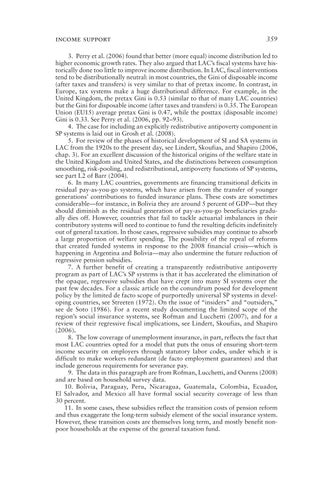income support
359
3. Perry et al. (2006) found that better (more equal) income distribution led to higher economic growth rates. They also argued that LAC’s fiscal systems have historically done too little to improve income distribution. In LAC, fiscal interventions tend to be distributionally neutral: in most countries, the Gini of disposable income (after taxes and transfers) is very similar to that of pretax income. In contrast, in Europe, tax systems make a huge distributional difference. For example, in the United Kingdom, the pretax Gini is 0.53 (similar to that of many LAC countries) but the Gini for disposable income (after taxes and transfers) is 0.35. The European Union (EU15) average pretax Gini is 0.47, while the posttax (disposable income) Gini is 0.33. See Perry et al. (2006, pp. 92–93). 4. The case for including an explicitly redistributive antipoverty component in SP systems is laid out in Grosh et al. (2008). 5. For review of the phases of historical development of SI and SA systems in LAC from the 1920s to the present day, see Lindert, Skoufias, and Shapiro (2006, chap. 3). For an excellent discussion of the historical origins of the welfare state in the United Kingdom and United States, and the distinctions between consumption smoothing, risk-pooling, and redistributional, antipoverty functions of SP systems, see part I.2 of Barr (2004). 6. In many LAC countries, governments are financing transitional deficits in residual pay-as-you-go systems, which have arisen from the transfer of younger generations’ contributions to funded insurance plans. These costs are sometimes considerable—for instance, in Bolivia they are around 5 percent of GDP—but they should diminish as the residual generation of pay-as-you-go beneficiaries gradually dies off. However, countries that fail to tackle actuarial imbalances in their contributory systems will need to continue to fund the resulting deficits indefinitely out of general taxation. In those cases, regressive subsidies may continue to absorb a large proportion of welfare spending. The possibility of the repeal of reforms that created funded systems in response to the 2008 financial crisis—which is happening in Argentina and Bolivia—may also undermine the future reduction of regressive pension subsidies. 7. A further benefit of creating a transparently redistributive antipoverty program as part of LAC’s SP systems is that it has accelerated the elimination of the opaque, regressive subsidies that have crept into many SI systems over the past few decades. For a classic article on the conundrum posed for development policy by the limited de facto scope of purportedly universal SP systems in developing countries, see Streeten (1972). On the issue of “insiders” and “outsiders,” see de Soto (1986). For a recent study documenting the limited scope of the region’s social insurance systems, see Rofman and Lucchetti (2007), and for a review of their regressive fiscal implications, see Lindert, Skoufias, and Shapiro (2006). 8. The low coverage of unemployment insurance, in part, reflects the fact that most LAC countries opted for a model that puts the onus of ensuring short-term income security on employers through statutory labor codes, under which it is difficult to make workers redundant (de facto employment guarantees) and that include generous requirements for severance pay. 9. The data in this paragraph are from Rofman, Lucchetti, and Ourens (2008) and are based on household survey data. 10. Bolivia, Paraguay, Peru, Nicaragua, Guatemala, Colombia, Ecuador, El Salvador, and Mexico all have formal social security coverage of less than 30 percent. 11. In some cases, these subsidies reflect the transition costs of pension reform and thus exaggerate the long-term subsidy element of the social insurance system. However, these transition costs are themselves long term, and mostly benefit nonpoor households at the expense of the general taxation fund.
